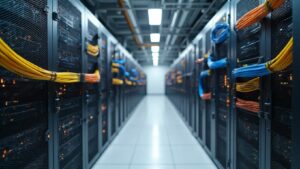
High tech industries are the superheroes of the modern economy, swooping in to save the day with innovation and cutting-edge solutions. From artificial intelligence to quantum computing, these sectors are not just pushing boundaries; they’re redefining what’s possible. If you think your smartphone is cool, wait until you see what’s brewing in the labs of Silicon Valley and beyond.
High Tech Industries
High-tech industries encompass sectors that leverage advanced technologies to drive innovation. These sectors play crucial roles in shaping economic landscapes while facilitating significant advancements. Notably, artificial intelligence, biotechnology, and quantum computing exemplify core areas where high-tech industries excel.
Artificial intelligence has rapidly transformed various markets. Companies developing AI solutions improve efficiency, enhance customer experiences, and create new business models. Their influence permeates sectors such as healthcare, automotive, and finance, leading to more personalized services.
Biotechnology demonstrates how high-tech advancements impact human health. Firms focused on genetic engineering and pharmaceuticals develop breakthroughs in treatments for diseases. Innovations in this sector also include advancements in agricultural biotechnology, which enhance crop yields and sustainability.
Quantum computing emerges as a groundbreaking field with immense potential. Organizations pioneering this technology aim to solve complex problems that traditional computers cannot efficiently address. Applications range from drug discovery to optimization in logistics.
Silicon Valley stands as a hub for high-tech innovation, attracting talent and investment. Startups and established firms alike drive developments from this region, fostering an ecosystem that encourages collaboration and creativity. The concentration of resources in Silicon Valley creates a fertile ground for technological breakthroughs.
Navigating the future, high-tech industries continue to evolve. Emerging technologies like augmented reality and 5G networking showcase the ongoing trend toward greater connectivity and immersive experiences. Leaders in these sectors are well-positioned to shape the next wave of technological evolution.
Key Players in High Tech Industries

High-tech industries feature a diverse range of prominent players. They include major companies and emerging startups driving the sector’s innovation forward.
Major Companies
Leading firms dominate the high-tech landscape. Apple, a giant in consumer electronics, consistently pushes boundaries in design and technology. Google excels in software and AI technologies, continuously enhancing user experiences. Microsoft shapes productivity software and cloud solutions, providing vital services to businesses globally. Amazon revolutionized e-commerce and cloud computing, expanding its influence across various sectors. Intel plays a critical role in semiconductor innovation, powering devices worldwide. These companies invest heavily in research and development, ensuring they remain competitive and at the forefront of technological advancements.
Emerging Startups
Startup companies contribute significantly to high-tech innovation. They often disrupt established markets with fresh ideas. For instance, OpenAI focuses on developing safe artificial intelligence systems to improve various sectors. Quantum computing startups like Rigetti Computing explore new computational possibilities. Biotech entrants such as Ginkgo Bioworks leverage genetic engineering to create sustainable solutions in agriculture and pharmaceuticals. Additionally, companies like Magic Leap work on augmented reality technologies, aiming to transform how users interact with digital content. These startups bring agility and creativity, continuously shaping the future of high-tech industries.
Trends Shaping High Tech Industries
High-tech industries are rapidly evolving due to several influential trends. These trends include advancements in artificial intelligence, the rise of the Internet of Things, and innovations in renewable energy technologies.
Artificial Intelligence and Machine Learning
Artificial intelligence and machine learning drive significant changes across industries. Firms utilize AI to automate processes, enhance customer interactions, and optimize operations. Machine learning algorithms analyze large datasets, offering insights that improve decision-making. In healthcare, AI-enabled tools assist in diagnostics, while in finance, predictive analytics enhance risk assessment. The integration of these technologies elevates productivity, fostering innovative solutions that reshape traditional business models.
Internet of Things (IoT)
The Internet of Things continues to transform connectivity and data exchange. Devices increasingly communicate with one another, collecting and sharing real-time information. Smart home technology exemplifies IoT’s impact, allowing users to control appliances remotely. Industries such as manufacturing leverage IoT for supply chain management, resulting in enhanced efficiency. By implementing IoT solutions, businesses gain valuable insights into operations, leading to data-driven strategies that optimize performance.
Renewable Energy Technologies
Renewable energy technologies are gaining traction in high-tech industries. Solar, wind, and bioenergy innovations reduce dependence on fossil fuels. Companies invest in energy storage solutions to enhance the reliability of renewable sources. Electric vehicles illustrate the shift toward sustainable energy, contributing to lower emissions and cleaner air. As more organizations embrace renewable technologies, the potential for widespread adoption grows, promoting environmental sustainability in various sectors.
Challenges Facing High Tech Industries
High-tech industries face several challenges that can hinder growth and innovation. Understanding these issues helps in strategizing for the future.
Supply Chain Disruptions
Supply chain disruptions significantly impact high-tech industries. Global events, such as pandemics and geopolitical tensions, lead to shortages in raw materials and components. The reliance on global suppliers complicates logistics, causing delays in production schedules. For instance, semiconductor shortages have slowed device manufacturing across sectors like automotive and electronics. Efficient supply chain management becomes essential to mitigate these risks. Companies must invest in diversifying suppliers and increasing inventory levels to ensure continuity.
Workforce Skills Gap
Workforce skills gaps present a challenge for high-tech companies. Rapid technological advancements necessitate a continuous updating of skills. Workers often find themselves inadequately trained for new roles that demand expertise in areas like artificial intelligence and data analytics. Many industries face difficulties in attracting qualified candidates due to this skills shortage. Tailored training programs and partnerships with educational institutions can help bridge these gaps. Promoting STEM education can ensure a pipeline of talent that meets the evolving demands of high-tech fields.
Future Outlook for High Tech Industries
Technological advancements indicate a promising trajectory for high-tech industries. Artificial intelligence is set to further integrate into sectors like healthcare and finance, enhancing operational efficiency. Predictions suggest that biotechnology will continue developing innovative treatments, revolutionizing patient care and agricultural methods. Quantum computing, with its potential to perform complex calculations, is gaining momentum and is expected to solve previously intractable problems.
Emerging technologies are likely to redefine connectivity and user experiences. Augmented reality will become more prevalent, offering immersive interactions that enhance user engagement across various applications. The rollout of 5G networking is anticipated to facilitate faster data transfer, paving the way for smarter cities and enhanced IoT applications.
Significant investments in research and development by major companies like Google and Microsoft will drive innovations. New startups such as OpenAI and Ginkgo Bioworks will continue to challenge norms, contributing groundbreaking solutions and technologies. Their collective efforts will foster an environment rich in creativity and innovation, setting the stage for unprecedented technological breakthroughs.
In addition, the industry is poised to address challenges effectively. Companies are prioritizing supply chain resilience to mitigate disruptions caused by global events. Enhanced partnerships with educational institutions are essential to bridge the skills gap in the workforce, ensuring that talent meets the evolving demands of high-tech fields.
Finally, the commitment to sustainability is expected to shape future innovations. Advancements in renewable energy technologies will likely reduce reliance on fossil fuels and promote environmental responsibility. Adopting these trends will not only foster economic growth but will also lead to a more sustainable future for high-tech industries.
Conclusion
High-tech industries are on a remarkable trajectory that promises to reshape the future of technology and the economy. With innovations in artificial intelligence biotechnology and quantum computing at the forefront these sectors are not just driving advancements but also addressing critical challenges.
The collaboration between established companies and emerging startups is vital for fostering a culture of innovation. As industries adapt to new technologies and shifting market demands they’ll continue to pave the way for sustainable growth and transformative solutions.
The commitment to enhancing supply chain resilience and bridging the workforce skills gap will further empower these sectors. By embracing sustainability and investing in research and development high-tech industries are poised to lead the charge into a new era of technological evolution.








